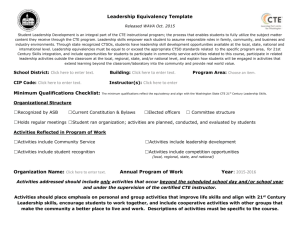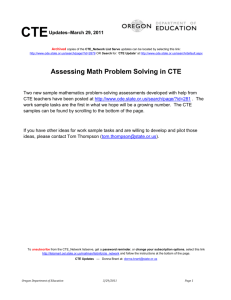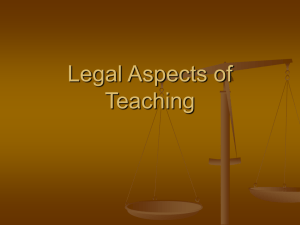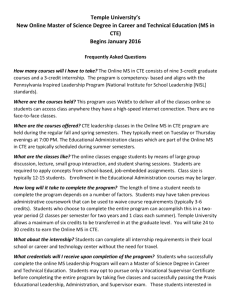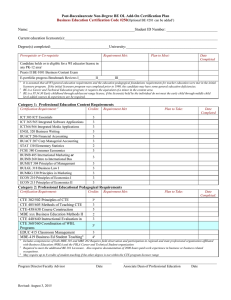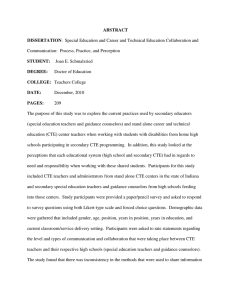Summer Math Institute
advertisement
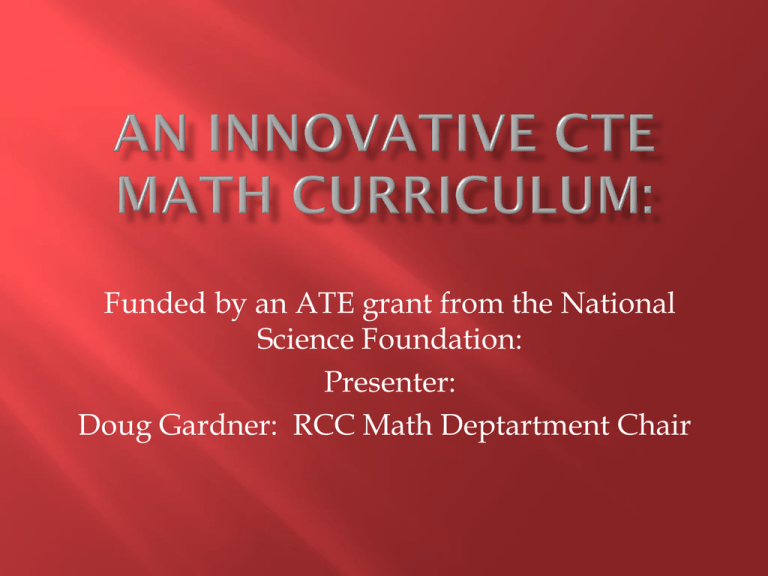
Funded by an ATE grant from the National Science Foundation: Presenter: Doug Gardner: RCC Math Deptartment Chair 2 Aspects of our study Applied Technical Mathematics Book Summer Math Institute Can we design an applied math curriculum and offer professional development sufficient for math teachers who do not have a CTE background? Contextualizing Career Technical Education in Math National Science Foundation CTE = Career Technical Education NSF = National Science Foundation NSF Project: two aspects/ two levels of education Curriculum: Dissemination of curriculum Professional development Community College High School Coordination: Agenda: Daily: Framed the math topic In college lab doing project Electronics, Welding, Manufacturing, Construction, Diesel Practiced the Math used from the text book Post- SMI: follow up professional learning community Will contextualized curriculum increase student success in terms of progression in math classes? Comprehension and application of math in CTE program of study? Does contextualized teaching energize and increase efficacy of teachers in high school and community college. NSF-RCC-SMI This school year, I am using the textbook and have had great success thus far. This curriculum and the real world examples have not only allowed students to see the connection between math and the CTE fields, but also helped them to realize that it is not just another class that they need to pass in order to graduate. – Shayna Dortch, Math and Computer Science Teacher, Prospect Charter School NSF-RCC-SMI This summer session opened my eyes to the many applications in CTE programs that can be brought into an Algebra and Geometry classroom. These students can never ask that common question of, “When will I ever use it?” – Kathy Alexander, Math Teacher, Eagle Point High School Student Testimonies: • “This is the first math class I have passed ( got a “C” or better on.)” • Several students who failed Geometry horribly last year have connected with this curriculum & methods and now consistently have earned a “C.” A 5th year senior sees a purpose in learning the math from the applied problems, and her dreams of graduating are coming true. • • Students who have been successful taking more advanced math courses have enjoyed the hands on and applied approach to learning. Elliptical Arch Average Weight Math 63 Activity Section 1.4: Radar Gun Simulation Materials: Tape Measures, Timers, Marbles, Tape The speed of a car can be determined by measuring the distance it travels in a short period of time. Distance: Time: Speed (MPH) Speed (KPH by measuring the distance it travels in a short period of time. Radar Gun Simulation Math 63 Activity Section 2.1: Sheet Metal Rectangular Prism Design Materials: Paper, Rulers, Scissors, Tape Directions: Use the volume formula to design and build a rectangular prism with a volume of 192 cm3. Include dimensions on your box. One possible lay out for the 6 sides is shown. Extension: Design and build a rectangular prism with a surface area of 240 cm2. Students: Keep remarking about the connections to CTE courses they are taking. Are more willing to participate in class. Have never doubted the validity of what they are learning. Students: Are motivated and happy to work on activities. Are interested. Are engaged in learning. Participate in cooperative learning and small group work which promotes team building. Talk about activities and share ideas. Have the time to discover new ideas. Get out of the classroom on occasion. Instructors: Have a difficult decision in choosing which high quality activity to use. Change teaching style from lecture to discovery approach. Become more of a facilitator than director. Create a revolutionary way to grade homework. Have camaraderie with CTE teachers who often give advice and come to help present a topic or explain how a tool or instrument is used. OACTE Presenters: Doug Gardner - dgardner@roguecc.edu Summer Math Institute 2014: June 16 -17 Rogue Community College


